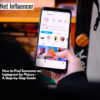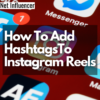Technology
Curastory: Unlocking Sustainable Monetization For Content Creators
This year is projected to be the first time that monthly social media users will surpass TV viewers in the United States.
Yet, creator earnings haven’t kept pace with this historic audience migration. The financial infrastructure connecting trillion-dollar advertising budgets to individual content creators remains fragmented, inefficient, and inaccessible to all but the top 1% of creators.
This insight comes from Tiffany Kelly, founder & CEO of Curastory and former ESPN Sports Analytics Associate.
Curastory’s market analysis reveals a sobering imbalance in the creator economy: while the total addressable market for monetizing the estimated 500 million people who have posted videos on platforms like TikTok amounts to roughly $652 billion, advertisers are currently spending only about $282 billion on creator advertising.
This gap translates to approximately half of all creators being unable to monetize their content effectively. “For every two creators, one of them’s getting monetized, and the other is not,” Tiffany explains.
She notes that although advertisers recognize that creator-produced content consistently outperforms brand-created assets on social platforms, the infrastructure to allocate advertising budgets to creators at scale efficiently has been missing—a structural market failure Curastory aims to solve.
“We are a video enablement tool for creators, allowing them to build video media businesses,” Tiffany explains. “We’re the first programmatic media buying technology platform for creator in-video advertisements. For the first time in history, we allow advertisers to get ad inserts within creator videos across social, done in their voice, just like a TV placement.”
Programmatic Advertising: How Curastory’s Technology Works
Curastory’s value proposition lies in adapting the programmatic advertising model that powers traditional media to individual creators. Unlike conventional influencer platforms where brands browse and select creators, Curastory functions more like traditional ad platforms.
“Advertisers come in, they run their campaigns. In their campaigns, they’re targeting keywords, the audience they want to target, such as age demographics, gender demographics, location, engagement,” Tiffany details. “After that, they submit their credit card and a press run, and then it’s up to [the ad platform].”
Behind the scenes, Curastory’s technology transcribes creator videos, extracts keywords and contextual information, and automatically matches relevant brand ad campaigns to appropriate content. “We pull keywords from the videos like what the creators are saying and match that with the ad campaign,” Tiffany explains.
Creators receive ad opportunities that align with their content and can accept or decline them within the platform. When accepted, they record the brand message in their own voice and integrate it into their video. After integration, videos are distributed across multiple platforms, and performance tracking is obtained across all channels.
The technical infrastructure makes these contextual matches possible through natural language processing that understands content themes. “It’s based on content,” Tiffany emphasizes. “Let’s say it’s a beauty creator, but they upload a video of them traveling. We won’t send them a Sephora ad. We’ll most likely send them an Expedia or Airbnb ad running on the ad platform because it’s relevant to the content they’re talking about in the video.”
This technology-driven approach compresses the campaign timeline dramatically. “The fastest we’ve seen a piece of content with ad insert go live from the campaign being run is about four days,” Tiffany notes, adding, “If you ask anyone in influencer marketing, I think the average launch time for a campaign is minimum 11 weeks.” The platform on average delivers 4-6x return on investment for advertisers.
Beyond Monetization: A Complete Video Business Toolkit
Curastory positions itself as more than just an ad platform, offering a vast ecosystem for video creators.
“There are about five foundational enablement tools we offer within the platform,” Tiffany explains. “Editing, music licensing, monetization, one-click distribution of your videos from the Curastory platform to YouTube, Shorts, TikTok, Reels, Facebook Watch, and analytics. So we track earnings, views, likes, comments, etc., across your videos and those channels within one platform.”
For monetization, Tiffany emphasizes that Curastory provides “this programmatic, always on monetization model for their videos across social media. Just like a media company, a media network, and kind of like TV channels.”
The platform also features a content library launched in late 2023. “It’s a place where they can upload all their videos to Curastory and have all their video assets in one place,” Tiffany notes.
Real-World Success: How Creators and Brands Benefit
The Loops Beauty campaign exemplifies how Curastory drives ROI for advertisers. The viral face mask brand achieved impressive results by reaching audiences through contextually relevant creator content.
Tiffany explains how their matching technology works: “We had videos where creators weren’t talking about beauty or skincare. But still, what they were saying within the video was relevant to the keywords in the campaign for the advertiser.”
One creator successfully integrated Loops Beauty into a video about having a bad day at work. Tiffany explains, “She uploaded a video of her having a bad work day and, like, it wasn’t fun and her needing to rest or reset. And then the Loops Beauty self care reset ad was what the platform sent to her.” The result was seamless: “When you watch it on social, it looks like she did all of it in one editing take, but she didn’t, which is the uniqueness of our model.”
Curastory has also unlocked previously impossible monetization opportunities. “Wilson was a cool one,” Tiffany notes. “That was something very special we did with student-athletes. For the first time in history, they could monetize their game highlight footage and then put advertisements within that across social media.”
Market Positioning and Industry Bifurcation
Curastory has grown to serve approximately 400,000 creators and has established strategic partnerships with all four major advertising agencies of record—Omnicom-IPG, GroupM/WPP, Publicis/Digitas, and Dentsu/Carat. “We are currently working with all four of the big agencies of record, which is exciting. We’re the only programmatic platform for creator video advertising,” Tiffany shares.
What differentiates Curastory’s approach is its deliberate targeting of programmatic media buying teams. “I did that on purpose, like when selling the company,” Tiffany explains. “I want your programmatic team to use the Curastory platform because the buy differs. It’s like credit card charges; it’s what they’re used to doing for TV and it’s the only model that really scales with consistent payouts for thriving creator businesses.”
This strategic decision positions Curastory to capture portions of the massive advertising budgets these agencies control—”the entire book of business across all four advertising agencies of record, what they would typically spend in a channel like Curastory over 3 years is around 400, 500 million,” according to Tiffany.
Tiffany identifies an emerging structural division in the creator economy market. “I think the market is just separating between those two categories,” she observes. Traditional influencer marketing involves manual selection processes where “brands can browse influencers and do the manual selection and content approval.”
In contrast, programmatic creator media buying treats creators as media channels where “the brands don’t talk to the creators. They don’t even approve the placements. They’re just running the campaigns and getting inventory automatically and programmatically without ever having to talk to them or look at content.”
Curastory has deliberately positioned itself in the programmatic media buying category, with Tiffany noting, “We’re in a whole other area where it is media buying, programmatic TV spends like former TV spends coming to us.”
The Creator Middle Class: A Vision for Economic Sustainability
According to Tiffany, the current creator economy resembles a pyramid with severe economic stratification, with the vast majority of creators struggling to earn a living wage despite having substantial and engaged audiences.
“Ninety percent of creators and influencers are barely making above minimum wage and just above a livable salary,” Tiffany reveals. Her mission centers on democratizing the financial benefits of audience attention.
“I think some of the largest companies in the world offer financial empowerment,” Tiffany explains, citing Airbnb’s financial empowerment for people who open their homes to host, Uber for people who drive, and Shopify for people who build commerce businesses. Similarly, Tiffany sees Curastory as providing creators with essential financial infrastructure within advertising technology.
Her passion for solving this problem is evident: “Being able to activate and turn on a monetization model that is programmatic and automated, just like TV allows and unlocks billions of media buying dollars… I mean just so much money and capital to where creators can make a livable wage,” she explains. “That’s the biggest thing, which is why I wake up every day to work on this.”
“Everyone talks about the creator economy, but the sad, dark side is that many people can’t make a living from actually doing it, whereas media companies do,” Tiffany concludes. “And so creators are media companies, and it should be the same, but the infrastructure hadn’t been in place to do that before we existed and built the platform.”













